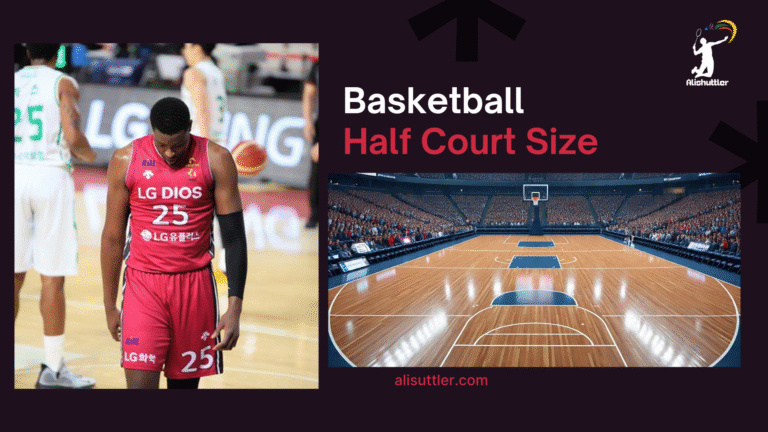Typically, a How Many Yards in a Basketball Court is 31.3 yards long and 16.7 yards wide. These figures are based on the standard court size of 28.65 m x 15.24 m. Certain leagues or gyms may have smaller courts; however, the majority of professional and college games are played at this size.
It’s important to know the court size so that players, coaches and fans can understand the pace and style of play. Next up are court markings and typical changes in layouts by level.
Court Dimensions in Yards
Basketball courts have a few standard sizes and knowing just how big these courts are in yards can assist players, coaches, and fans alike grasp the scale of the game. On all levels, the court’s width is nearly always 16.67 yards (50 feet), while the court aspect dimensions length varies by level of play. These distinctions impact the game and how basketball players prepare for the next level.
- NBA court dimensions are 94 x 50 feet or 31.33 x 16.67 yards.
- NCAA courts are the same dimension as the NBA at 94’ (31.33 yards) x 50’ (16.67 yards).
- High school courts are 84 feet by 50 feet (28 x 16.67 yards).
- FIBA courts are 28 meters (30.62 yards) by 15 meters (16.40 yards).
- An NBA half-court is 47 feet long (15.67 yards).
- The key is 16 feet (5.33 yards) wide and 19 feet (6.33 yards) long.
- The three-point line arcs from 5.63 yards from the rest point (the top of the arc) at 7.38 yards.
- The restricted area below the basket consists of a radius of approximately 1.37 yards.
1. NBA
NBA courts, on the other hand, are 31.33 yards by 16.67 yards. This size is used in all NBA arenas, so play is uniform throughout the league all teams, all cities.
The NBA’s standardized size allows players to train with a familiar court. Coaches call plays and set defenses with the confidence that the court’s dimensions won’t shift. The width – 16.67 yards – is the same as in high school and college, but the 31.33-yard length gives pros more room to run, pass, and build up speed.
Court dimensions influence play, allowing speedy players to exploit the width and granting shooters additional room. It means players need the endurance to cover a lot of court, which influences how teams condition and strategize.
2. FIBA
FIBA, which oversees international basketball, uses a court that’s 28 meters long (approx. 30.62 yards) and 15 meters wide (approx. 16.40 yards). This court is just a tad shorter and narrower than the NBA size.
FIBA’s global rules mean teams from different nations compete on nearly identical courts. That small discrepancy counts—NBA players accustomed to 31.33 yards now have to adapt to the 30.62-yard FIBA court during the Olympics or World Cup. This can alter tactics and player movement.
FIBA’s measurements define basketball for nearly every other country on Earth, including how the game is coached and played internationally. FIBA’s court dimensions standardize competition globally. It influences how young players outside the U.S. Are taught the game, preparing them to more easily participate in global tournaments.
3. NCAA
NCAA courts are 94 feet by 50 feet (31.33 yards by 16.67 yards). These dimensions are in line with the NBA, so the transition from college to pro is a little more fluid.
College players become accustomed to the very same court size they’ll encounter should they make the jump to the NBA. This aids skill development and makes the leap to the next level less jarring.
High school courts, at 28 yards long, are shorter. So the transition to NCAA play equates to more running and a quicker tempo, which allows students to mature as athletes.
4. High School
High school courts are 28 x 16.67 yards. This is shorter than their college and pro counterparts but the same width.
The reduced size acclimates young players to the game without so much running. Junior high courts, which are frequently the same size as a high school one, so the transition as players age is smoother.
The handier high school court primes athletes for the longer, speedier college or pro game. Court size at the youth level shapes skill growth.

Beyond Length
Court length typically steals the attention, yet court width influences the rhythm of basketball at all levels. The width influences the way teams space, construct plays and defend. Even small variations in court dimensions affect the rhythms and flow of play, which is why width is such an important consideration for coaches and players as well as facility planners.
NBA and NCAA courts are 50 feet (15.24 meters) wide. FIBA courts measure 15 meters wide (49.21 feet). High school courts in many countries, such as the US, are 50 feet (15.24 m) wide. Youth and recreational courts can sometimes be smaller at 42 feet (12.8 meters) wide. Width impacts not only spacing, but the way players screen, cut, and defend the perimeter.
Width
For reference, an NBA and NCAA court is 50 feet (16.67 yards) wide. FIBA courts are a little narrower at 15m, just over 16.4 yards. High school courts tie NBA/NCAA width at 50 feet, while certain youth and rec leagues are as narrow as 42 feet (14 yards). Even that little bit of difference between FIBA and NBA courts can impact player movement and getting plays going.
A larger court expands the defense and provides shooters additional space on the perimeter. This has only gotten more significant since the advent of the three-point lines, originally tested in 1961. Today, the NBA three-point line sits at 23′ 9′ (7.24 m) at the top, 22′ (6.71 m) in the corners, while FIBA’s is just over 22′ (6.75 m). The additional width in the NBA translates into more room for shooters and more ground to cover for defenders.
Total Area
The footprint of an NBA or NCAA court is 4700 square feet, or roughly 522.2 square yards. For FIBA, it’s 420 square meters, or about 502.3 square yards. High school courts can be 4200 square feet or 466.7 square yards. Half-courts, typical for practice and pick-up games, are approximately 2350 square feet, or 261.1 square yards.
| Court Type | Area (sq. yards) |
|---|---|
| NBA/NCAA | 522.2 |
| FIBA | 502.3 |
| High School | 466.7 |
| Half Court | 261.1 |
The court’s size neither advantages nor disadvantages either team, but the court’s shape changes things, for both offense and defense. Larger courts reward teams that can pass the ball quickly and space their shooters effectively. Defenders must chase more space, with the three-point line putting defenders further out than ever before. Coaches harness these truths to craft their game plans, whether they want to decelerate the action or accelerate it.
For facility planners, understanding precise court locations is essential for selecting flooring, arranging seating, and ensuring the space accommodates all levels of play.
Key Markings Translated
Basketball courts have lines, arcs, and zones to establish rules and dictate how the game operates. Each marking is significant, directing basketball players, informing strategies, and maintaining fairness. Understanding these markings is key to comprehending how teams advance and score on a professional basketball court.
Three-Point Arc
The three-point line still sits at different distances by league. In HS, the arc is 6.75 meters (around 7.4 yards) out from the basket. NCAA courts use a line about 6.75 meters (7.4 yards) – like FIBA. The NBA three-point line is farther out at 7.24 meters (7.92 yards) from the basket at the top of the arc; however, it’s a bit closer in the corners.
That discrepancy alters the way teams shoot and score. In leagues with shorter arcs, outside shots are prevalent. The NBA’s longer arc means players have to be more skilled and stronger to score from deep, so it can space the floor and open up the paint for other play.
The three-ball is now a huge piece of the vast majority of offenses, allowing squads to quickly get back in the game or create leads with effective shooters.
The Key
The key, or free throw lane, is a rectangle under the basket. It measures 5.8 meters (6.34 yards) by 4.8 meters (5.25 yards) in the majority of courts. It’s 16 feet (4.88 m or 5.34 yd) wide in the NBA and FIBA, but was once a trapezoid.
The key influences where players position themselves for free throws and in play movement. It’s where a ton of activity takes place — post moves, layups, rebounds. The paint houses the restricted arc, a four-foot (1.22 meters) radius under the basket that prevents defenders from taking charges.
Knowing the key’s shape and size assists teams in strategizing offense and defense near the basket.

Free Throw Line
The free throw line is 4.57m (5 yards) from the backboard on all standard courts—high school, NCAA, NBA, and FIBA. This separation makes free throws a challenge of technique and temperament.
Shooting from this line is identical anywhere, allowing players to develop real habits that translate across leagues. The free throw line is not just shooting; it’s a psychological test, as players stand alone and the game goes into pause mode.
Its fixed distance allows coaches to strategize and referees to maintain fairness.
Center Circle
The center circle, where the opening jump ball occurs, is 3.6 meters across (roughly 2 yards radius). This circle is nearly identical in all leagues, so teams know what to expect at tip-off.
The center circle fixes the rhythm and marks the place of play’s origins. Players employ it for jump balls and occasionally for fast passes or set plays.
Why Dimensions Matter
In other words, basketball court size influences the way the game is played, coached, and appreciated. Understanding dimensions in meters or yards enables coaches, players, and designers to develop equitable and efficient arenas for play. Each facet of the court, from the basketball goal’s height to the key measurements, serves a deliberate function impacting skill, motion, and even safety.
- Helps coaches design drills that match game spaces
- Prepares players for official court sizes in competitions
- Assists coaches in designing conditioning regimes for particular court lengths
- Ensures that skill development matches actual game conditions
- Supports accurate measurement for setting up equipment and markings
- Promotes fair play by reducing confusion about boundaries
Gameplay Impact
Court size alters the pace of the game. A longer and wider court implies more running by the players, forcing teams to rely on speed and stamina. On smaller courts, no-look passes and tight defense are more prevalent because there’s less space to cover.
A player’s mobility and reflexes connect to the court’s size. On a traditional court, spacing helps players utilize their quickness on the fast break or to pick up a defender. Scoring and defending both rely on proximity to the hoop, with the three-point line and key width moving how teams assault or defend the basket.
For instance, a wider key allows players to cut more liberally, whereas a narrow key congests the paint and alters the way teams defend on the interior. Teams who adjust their style to the precise court size—by pressing more or spacing out shooters—gain a distinct advantage.
Player Strategy
Players must adjust their strategy for professional basketball court dimensions. With a larger basketball court size, offensive players gain more room to maneuver without colliding with defenders, making it easier to set screens and create open shots. On the defensive side, teams may need to cover more ground, which involves increased running and quicker switches.
Space clever is the secret! Athletes who can estimate court landmarks, such as the 15-foot free-throw line or the 4-foot restricted area, can locate the optimal locations for shots or blocks. Over time, practicing on the right court dimensions cultivates habits and hones awareness — critical for competitive play and player development.
The “Feel”
Court size affects the “feel” of the game. Players feel how much space they have, how fast to go, when to shoot or pass because of well-defined boundaries and accurate markings. A recognizable court design soothes jitters, whereas a few minor quirks of the room can disrupt rhythm or faith.
Players who practice on accurately dimensioned courts develop a feeling for space and timing that aids them during actual matches. They believe their movements more, aware the lines and hoops correspond to what they’ll experience in game.
A Global Perspective
Basketball court sizes can differ from country to country, but the goal remains the same: fair play, clear rules, and a level playing area for athletes everywhere. Standardizing measurements, especially for professional basketball, ensures the court speed and dimensions are consistent, particularly in global tournaments. Understanding these differences helps players, coaches, and fans grasp the dynamics on the court, regardless of their origin.
Meters vs. Feet for How Many Yards in a Basketball Court
Courts, in feet here and meters there, can vary significantly in basketball court size. FIBA utilizes meters, with standard courts measuring approximately 28 by 15 meters, while the NBA specifies its professional basketball court dimensions as 94′ x 50′. This difference highlights the importance of conversions when comparing leagues or preparing for games in a new country.
Switching between meters and feet can be confusing, especially given that the FIBA three-point line is set at 6.75 meters (22’ 1.75″) and the NBA’s at 7.24 meters (23’ 9″). These adjustments are not trivial—they significantly affect how basketball players shoot and defend on the court.
International players and coaches must stay sharp, understanding both systems and knowing how to pivot their play accordingly. Transparent communication about which measurements are being used is vital, ensuring all parties are prepared for the specific court setup.
The 20-Meter Question
The 20 meter figure arises in discussions of basketball court size, as it’s near the length of various half-courts used in youth or amateur leagues. Although most professional basketball courts exceed that distance, FIBA’s sits at roughly 28 meters and NBA at close to 29. Understanding where 20 meters falls provides a good frame of reference.
For 3 pt shooters, the court’s length and 3 pt arc mean a lot. The NBA arc is just over 7 meters and FIBA’s a bit shorter. Put that up against 20 meters (21.87 yards) and it’s easier to understand just how much distance basketball players cover on the pitch.
This gap is an issue as well in international competitions, where regulations toggle from league to league. It keeps the emphasis on talent, not just enormity.

Unifying with Yards
If only yards were some kind of standard to measure against, such as to help stave off the collision between metric and imperial. Because a yard is about 0.91 meters or three feet, it’s a nice middle ground that works for the metric and imperial crowds.
If we all used yards, it would be easier for players cross-training in other countries to remember the court sizes. Standardized metrics would further assist coaches in devising drills and strategies that apply everywhere.
For players, that a court is always 30 yards long, for instance, removes the guesswork from practice and play. Keeping court measurements transparent and uncomplicated makes basketball more accessible. Less hassle and more game.
Practical Measurement
Basketball courts may appear identical, but the specifics are important. Standard court size is set by sport regulations, however routine inspections and exact measurements ensure gameplay is equitable and secure. For all stakeholders, from facility managers to athletes, precision is key.
Use this checklist for keeping measurements on point: confirm court length and width, check all arcs and lines, inspect the safety zone around the play area, and make sure the basket height is correct. Proper instruments—tape measure, laser distance measurer, chalk line—are required for dependable outcomes. Exact measurements fuel reliable playing, guarantee safety, and create impactful training.
Conversion Factors
The conversion factor is simple: 1 yard equals 3 feet. For a regulation court, 94 feet is roughly 31.3 yards, and 50 feet is 16.7 yards. Quick math: divide feet by 3 for yards.
For instance, a 45-foot half-court is 15 yards long. Knowing this comes in handy when you read plans or talk about courts internationally. Designers have to translate measurements for international standards and athletes want yard-based distances in workout plans. Accurate conversions ensure that everyone is speaking the same language, whether establishing a new gym or conducting a skills camp.
Marking a Court
Marking begins with measuring the court’s length and width, then using a chalk line or tape to lay out the boundaries. Next come the key features: the free throw lane (16 feet wide for pro, 12 feet for lower levels), the three-point arc (23 feet 9 inches for pros, closer for high schools), and the restricted area arc (4 feet from the basket’s center).
Clear, bright paint or tape make lines easy to see. Carefully rechecking each mark is crucial; even a minor mistake impacts the flow of play. For pointers, measure twice, draw with a straightedge, and level the basket at 10 feet high. Quality lines direct players and officials, minimize injury and keep the attention on the action.
Required Space
A full court requires 94 by 50 feet, however safety zones count. Include 3-10 feet of clearance around all sides for safe movement and emergency access. High school courts are a little shorter at 84 x 50 feet, and half-courts can be different — popular configurations for 3-on-3 include 45 x 35 feet, or 37 x 42 feet for kids.
Pro courts require additional room for fans and personnel. At any level, schedule buffers, almacenes, seats from the beginning.
Final Thoughts on How Many Yards in a Basketball Court
A basketball court is approximately 31 yards in length and 17 yards in width. Markings such as the free throw line sit approximately 4 yards from the basket. These realities mold the game, from easy buckets to fierce defense. Courts maintain consistent dimensions everywhere so the game plays evenly and fluidly regardless of where people play.
Coaches, players and fans all use these yards measures to plan, play and watch smarter. For those who require rapid checks, a measuring tape or step count can assist, even outside a gym. To find out more or against courts for other sports, see guides from reputable sporting organisations or inquire at local clubs. Be inquisitive and maintain the playfulness.
Frequently Asked Questions
How many yards long is a standard basketball court?
A regulation basketball court size measures approximately 28 meters in length, translating to around 31 yards.
How many yards wide is a basketball court?
The average basketball court size is approximately 15 meters across, translating to about 16.4 yards.
Are all basketball courts the same size in yards?
No, basketball court size varies. International courts are roughly 28 by 15 meters, and some school basketball courts are even smaller.
What is the length of a high school basketball court in yards?
A high school basketball court typically measures around 25 meters in length, aligning with standard size dimensions.
Why are basketball court dimensions measured in yards or meters?
Meters are the worldwide standard, but for certain basketball court sizes, it’s measured in yards in locations where the metric system is not widely used.
How do I measure a basketball court in yards?
Say, a meter stick. Then, multiply meters times 1.0936 to get yards for basketball court size.
Do the court markings also change when measured in yards?
No, the stripes are identical. Only the units differ for measurement. The basketball court size and design are the same.






